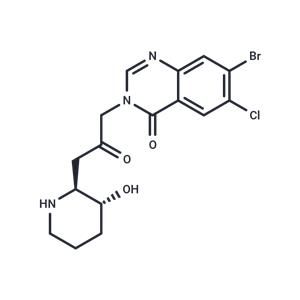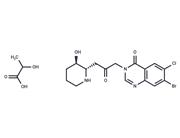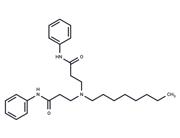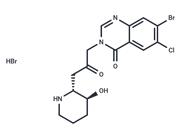| Name | Halofuginone |
| Description | Halofuginone (RU-19110), the competitive inhibitor of prolyl-tRNA synthetase(Ki=18.3 nM), could also down-regulate Smad3 and blocked TGF-β signaling at 10 ng/ml in the mammal. |
| Cell Research | Primary murine CD4+ CD25− T cells are activated through the TCR in Th17 polarizing conditions in the presence of either 10 nM MAZ1310 or HF and amino acid supplements. Th17 differentiation is assayed in the absence or presence of HF or borrelidin, with or without 1 mM threonine or proline supplementation. MEFs are treated with or without HF (50 nM) and/or Proline (2 mM) for 4 hours (CHOP, S100A4) or 24 hours (ColIA1, Col1A2). (Only for Reference) |
| Kinase Assay | Assay of ProRS activity: The prolyl tRNA synthetase domain of human EPRS (ProRS) is expressed in E.coli with a 6-his tag and purified. Enzymatic activity is assayed using incorporation of 3H Pro into the tRNA fraction essentially, except that the charged tRNA fraction is isolated by rapid batchwise binding to Mono Q sepharose and quantitated by liquid scintillation counting. For all kinetic assays, the concentration of active enzyme in the reaction is 40 nM. Similar inhibition by HF is seen using the human ProRS domain purified from bacteria and full length EPRS purified from rat liver. |
| In vitro | In mammals, halofuginone at 10 ng/ml down-regulates Smad3, blocking TGF-β signaling and preventing both the differentiation of fibroblasts to myofibroblasts and the transitioning of epithelial cells to mesenchymal cells[2]. |
| In vivo | Halofuginone clearly extends the survival times of the parasite-infected mice. Oral treatment with halofuginone at doses of 0.2 and 1 mg/kg has an apparent curative effect for the infected mice. The subcutaneous administration of 0.2 mg of halofuginone per kg likewise extends the survival times of the infected mice, but none of the mice is cured. The mice in the 5-mg/kg dose groups die before the completion of treatment with the drug either orally or subcutaneously. Subcutaneous treatment with halofuginone appears to be more toxic to mice than oral treatment[3]. |
| Storage | Powder: -20°C for 3 years | In solvent: -80°C for 1 year | Shipping with blue ice/Shipping at ambient temperature. |
| Solubility Information | 10% DMSO+40% PEG300+5% Tween 80+45% Saline : 1 mg/mL (2.41 mM), Sonication is recommended.
Ethanol : < 1 mg/mL (insoluble or slightly soluble)
DMSO : 4.15 mg/mL (10 mM), Sonication is recommended.
H2O : < 1 mg/mL (insoluble or slightly soluble)
|
| Keywords | type-I | Transforming growth factor beta | TGF-β/Smad | TGF-β | TGFβ | TGF-beta/Smad | TGFbeta/Smad | TGF-beta | TGFbeta | TGF-b/Smad | TGFb | SodiumChannel | Sodium Channel | Smad | RU19110 | RU 19110 | RNASynthesis | RNA Synthesis | prolyl-tRNA synthetase | prolyl-tRNA | Parasite | osteoarthritis | Halofuginone | DNASynthesis | DNA/RNA Synthesis | DNA Synthesis | collagen-1 | collagen | CalciumChannel | Calcium Channel |
| Inhibitors Related | 5-Fluorouracil | Flubendazole | Phenytoin sodium | Kojic acid | Urethane | L-Ascorbic acid | Hydroxychloroquine | Guanidine hydrochloride | Doxycycline | Valproic Acid | Thymidine | L-Ascorbic acid sodium salt |
| Related Compound Libraries | Anti-Tumor Natural Product Library | Anti-Parasitic Compound Library | Alkaloid Natural Product Library | Selected Plant-Sourced Compound Library | Anti-Cancer Clinical Compound Library | Antiparasitic Natural Product Library | Natural Product Library for HTS | Immunology/Inflammation Compound Library | Ion Channel Targeted Library | TGF-beta/Smad Compound Library | Anti-Cancer Active Compound Library | Anti-Cancer Drug Library |
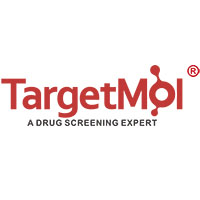
 United States
United States



